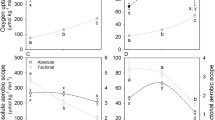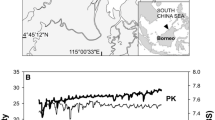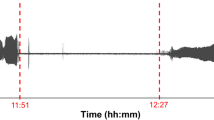Abstract
Among bivalves, scallops are exceptional due to their capacity to escape from predators by swimming which is provided by rapid and strong claps that are produced by the phasic muscle interspersed with tonic muscle contractions. Based on the concept of oxygen and capacity-limited thermal tolerance, the following hypothesis was tested: ocean warming and acidification (OWA) would induce disturbances in aerobic metabolic scope and extracellular acid-case status and impair swimming performance in temperate scallops. Following long-term incubation under near-future OWA scenarios [20 vs. 10 °C (control) and 0.112 kPa CO2 (hypercapnia) vs. 0.040 kPa CO2 (normocapnic control)], the clapping performance and metabolic rates (MR) were measured in resting (RMR) and fatigued (maximum MR) king scallops, Pecten maximus, from Roscoff, France. Exposure to OA, either alone or combined with warming, left MR and swimming parameters such as the total number of claps and clapping forces virtually unchanged. Only the duration of the escape response was affected by OA which caused earlier exhaustion in hyper- than in normocapnic scallops at 10 °C. While maximum MR was unaffected, warm exposure increased RMR in both normocapnic and hypercapnic P. maximus resulting in similar Q 10 values of ~2.2. The increased costs of maintenance and the observation of strongly reduced haemolymph PO2 levels indicate that at 20 °C scallops have reached the upper thermal pejus range with unbalanced capacities for aerobic energy metabolism. As a consequence, warming to 20 °C decreased mean phasic force during escape performance until fatigue. The observed prolonged recovery time in warm incubated scallops might be a consequence of elevated metabolic costs at reduced oxygen availability in the warmth.



Similar content being viewed by others
References
Aldridge DW, Payne BS, Miller AC (1995) Oxygen consumption, nitrogenous excretion, and filtration rates of Dreissena polymorpha at acclimation temperatures between 20 and 32°C. Can J Fish Aquat Sci 52:1761–1767
Alejandrino A, Puslednik L, Serb JM (2011) Convergent and parallel evolution in life habit of the scallops (Bivalvia: Pectinidae). BMC Evol Biol 11:164. doi:10.1186/1471-2148-11-164
Bailey DM, Peck LS, Bock C, Pörtner HO (2003) High-energy phosphate metabolism during exercise and recovery in temperate and Antarctic scallops: an in vivo 31P-NMR study. Physiol Biochem Zool 76:622–633
Booth CE, McDonald DG, Walsh PJ (1984) Acid–base balance in the sea mussel, Mytilus edulis. I. Effects of hypoxia and air-exposure on hemolymph acid–base status. Mar Biol Lett 5:347–358
Chantler PD (2006) Scallop adductor muscles: structure and function. In: Shumway SE, Parsons GJ (eds) Scallops: biology, ecology and aquaculture, 1st edn. Elsevier, Amsterdam, pp 229–316
Clark TD, Sandblom E, Jutfelt F (2013) Aerobic scope measurements of fishes in an era of climate change: respirometry, relevance and recommendations. J Exp Biol 216:2771–2782
Cutts CJ, Metcalfe NB, Taylor AC (2002) Juvenile Atlantic salmon (Salmo salar) with relatively high standard metabolic rates have small metabolic scopes. Funct Ecol 16:73–78
de Zwaan A, Thompson RJ, Livingston DR (1980) Physiological and biochemical aspects of the valve snap and valve closure responses in the giant scallop Placopecten magellanicus II. Biochemistry. J Comp Physiol B 137:105–114
Findlay HS, Kendall MA, Spicer JI, Widdicombe S (2010) Relative influences of ocean acidification and temperature on intertidal barnacle post-larvae at the northern edge of their geographic distribution. Estuar Coast Shelf S 86:675–682
Frederich M, Pörtner HO (2000) Oxygen limitation of thermal tolerance defined by cardiac and ventilatory performance in the spider crab, Maja squinado (Decapoda). Am J Physiol 279:R1531–R1538
Fry FE (1947) Effects of the environment on animal activity. Univ Toronto Biol Ser 55. Pub Ont Fish Res Lab 68:1–62
Grieshaber M (1978) Breakdown and formation of high-energy phosphates and octopine in the adductor muscle of the scallop, Chlamys opercularis (L.), during escape swimming and recovery. J Comp Physiol B 126:269–276
Guderley H (2004) Locomotor performance and muscle metabolic capacities: impact of temperature and energetic status. Comp Biochem Physiol B 139:371–382
Guderley H, Pörtner HO (2010) Metabolic power budgeting and adaptive strategies in zoology: examples from scallops and fish. Can J Zool 88:753–763
Guderley HE, Tremblay I (2013) Escape responses by jet propulsion in scallops. Can J Zool 91:420–430
Guderley H, Janssoone X, Nadeau M, Bourgeois M, Cortés HP (2008) Force recordings during escape responses by Placopecten magellanicus (Gmelin): seasonal changes in the impact of handling stress. J Exp Mar Biol Ecol 355:85–94
Guderley H, Labbé-Gigère S, Janssoone X, Bourgeois M, Pérez HM, Tremblay I (2009) Thermal sensitivity of escape performance by the scallop Placopecten magellanicus: impact of environmental history. J Exp Mar Biol Ecol 377:113–119
Hiebenthal C, Philipp EER, Eisenhauer A, Wahl M (2013) Effects of seawater pCO2 and temperature on shell growth, shell stability, condition and cellular stress of Western Baltic Sea Mytilus edulis (L.) and Arctica islandica (L.). Mar Biol 160:2073–2087
Ifremer (2011) Annual report 2011. http://www.ifremer.fr. Accessed 05 Dec 2012
IPCC (2014) Summary for Policymakers. In: Edenhofer O, Pichs-Madruga R, Sokona Y, Farahani E, Kadner S, Seyboth K, Adler A, Baum I, Brunner S, Eickemeier P, Kriemann B, Savolainen J, Schlömer S, von Stechow C, Zwickel T, Minx JC (eds) Climate change 2014, mitigation of climate change. Contribution of working group III to the Fifth Assessment Report of the Intergovernmental Panel on Climate Change. Cambridge University Press, Cambridge, United Kingdom and New York, NY, USA
Jones TO, Whyte JNC, Townsend LD, Ginther NG, Iwama GK (1995) Effects of domoic acid on haemolymph pH, PCO2, and PO2, in the Pacific oyster, Crassostrea gigas and the California mussel, Mytilus californianus. Aquat Toxicol 31:43–55
Lafrance M, Guderley H, Cliche G (2002) Low temperature, but not air exposure, slows the recuperation of juvenile scallops, Placopecten magellanicus, from exhausting escape responses. J Shellfish Res 21:605–618
Lannig G, Flores JF, Sokolova IM (2006) Temperature-dependent stress response in oysters, Crassostrea virginica: pollution reduces temperature tolerance in oysters. Aquat Toxicol 79:278–287
Lannig G, Cherkasov AS, Pörtner HO, Bock C, Sokolova IM (2008) Cadmium-dependent oxygen limitation affects temperature tolerance in eastern oysters (Crassostrea virginica Gmelin). Am J Physiol 294:R1338–R1346
Lindinger MI, Lawren DJ, McDonald DG (1984) Acid-base balance in the sea mussel Mytilus edulis. Effects of environmental hypercapnia on intra and extracellular acid-base balance. Mar Biol Lett 5:371–381
MacDonald BA, Thompson RJ (1986) Influence of temperature and food availability on the ecological energetics of the giant scallop, Placopecten magellanicus. III. Physiological ecology, the gametogenic cycle and scope for growth. Mar Biol 93:37–48
Melzner F, Gutowska MA, Langenbruch M, Dupont S, Lucassen M, Thorndyke MC, Bleich M, Pörtner HO (2009) Physiological basis for high CO2 tolerance in marine ectothermic animals: preadaptation through lifestyle and ontogeny? Biogeosciences 6:1–19
Michaelidis B, Ouzounis C, Paleras A, Pörtner HO (2005) Effects of long-term moderate hypercapnia on acid-base balance and growth rate in marine mussels Mytilus galloprovincialis. Mar Ecol Prog Ser 293:109–118
Minchin D (2003) Introductions: some biological and ecological characteristics of scallops. Aquat Living Resour 16:521–532
Morley SA, Hirse T, Thorne MAS, Pörtner HO, Peck LS (2012) Physiological plasticity, long term resistance or acclimation to temperature, in the Antarctic bivalve, Laternula elliptica. Comp Biochem Physiol A 162:16–21
Pazos AJ, Roman G, Acosta CP, Abad M, Sanchez JL (1997) Seasonal changes in condition and biochemical composition of the scallop Pecten maximus L. from suspended culture in the Ria de Arousa (Galicia, N.W., Spain) in relation to environmental conditions. J Exp Mar Biol Ecol 211:169–193
Peck LS, Pörtner HO, Hardewig I (2002) Metabolic demand, oxygen supply and critical temperatures in the Antarctic bivalve Laternula elliptica. Physiol Biochem Zool 75:123–133
Pérez HM, Janssoone X, Guderley H (2008a) Tonic contractions allow metabolic recuperation of the adductor muscle during escape responses of giant scallop Placopecten magellanicus. J Exp Mar Biol Ecol 360:78–84
Pérez HM, Janssoone X, Nadeau M, Guderley H (2008b) Force production during escape responses by Placopecten magellanicus is a sensitive indicator of handling stress: comparison with adductor muscle adenylate energy charge and phosphoarginine levels. Aquaculture 282:142–146
Pilditch CA, Grant J (1999) Effect of temperature fluctuations and food supply on the growth and metabolism of juvenile sea scallops (Placopecten magellanicus). Mar Biol 134:235–248
Pörtner HO (2001) Climate change and temperature-dependent biogeography: oxygen limitation of thermal tolerance in animals. Naturwissenschaften 88:137–146
Pörtner HO (2002) Environmental and functional limits to muscular exercise and body size in marine invertebrate athletes. Comp Biochem Physiol A 133:303–321
Pörtner HO (2008) Ecosystem effects of ocean acidification in times of ocean warming: a physiologist’s view. Mar Ecol Prog Ser 373:203–217. doi:10.3354/meps07768
Pörtner HO (2010) Oxygen- and capacity-limitation of thermal tolerance: a matrix for integrating climate-related stressor effects in marine ecosystems. J Exp Biol 213:881–893. doi:10.1242/jeb.037523
Pörtner HO, Farrell AP (2008) Physiology and climate change. Science 322:690–692
Pörtner HO, Bock C, Knust R, Lannig G, Lucassen M, Mark FC, Sartoris FJ (2008) Cod and climate in a latitudinal cline: physiological analyses of climate effects in marine fishes. Clim Res 37:253–270
Precht H, Christopherson J, Hensel H, Larcher W (1973) The time–temperature relation of heat killing. In: Precht H, Christopherson J, Hensel H, Larcher W (eds) Temperature and life, 1st edn. Springer, Berlin, pp 17–20
Rodolfo-Metalpa R, Houlbrèque F, Tambutté É, Boisson F, Baggini C, Patti FP, Jeffree R, Fine M, Foggo A, Gattuso J-P, Hall-Spencer JM (2011) Coral and mollusc resistance to ocean acidification adversely affected by warming. Nat Clim Change 1:308–312. doi:10.1038/NCLIMATE1200
Rosa R, Seibel BA (2008) Synergistic effects of climate related variables suggest future physiological impairment in a top oceanic predator. Proc Natl Acad Sci USA 105:20776–20780
Schalkhausser B, Bock C, Stemmer K, Brey T, Pörtner HO, Lannig G (2013) Impact of ocean acidification on escape performance of the king scallop, Pecten maximus, from Norway. Mar Biol 160:1995–2006. doi:10.1007/s00227-012-2057-8
Shriver AC, Carmichael RH, Valiela I (2002) Growth, condition, reproductive potential, and mortality of bay scallops, Argopecten irradians, in response to eutrophic-driven changes in food resources. J Exp Mar Biol Ecol 279:21–40
Shumway SE, Barter J, Stahlnecker J (1988) Seasonal changes in oxygen consumption of the giant scallop, Placopecten magellanicus (Gmelin). J Shellfish Res 7:77–82
Sokolova IM, Frederich M, Bagwe R, Lannig G, Sukhotin AA (2012) Energy homeostasis as an integrative tool for assessing limits of environmental stress tolerance in aquatic invertebrates. Mar Environ Res 79:1–15
Somero GN (2011) Comparative physiology: a “crystal ball” for predicting consequences of global change. Am J Physiol Regul Integr Comp Physiol 301:R1–R14. doi:10.1152/ajpregu.00719.2010
Thompson RJ, Livingstone DR, de Zwaan A (1980) Physiological and biochemical aspects of the valve snap and valve closure responses in the giant scallop Placopecten magellanicus I Physiology. J Comp Physiol 137:97–104
Tremblay I, Guderley HE, Himmelmann JH (2012) Swimming away or clamming up: the use of phasic and tonic adductor muscles during escape responses varies with shell morphology in scallops. J Exp Biol 215:4131–4143
Weiss RF (1974) Carbon dioxide in water and seawater: the solubility of a non-ideal gas. Mar Chem 2:203–215
Wittmann A, Pörtner HO (2013) Sensitivities of extant animal taxa to ocean acidification. Nat Clim Change 3:995–1001. doi:10.1038/nclimate1982
Acknowledgments
We would like to thank “Station Biologique de Roscoff“, especially Yann Fontana (diver) and Pascal Morin (SOMLIT sea water database), for their support in scallops and environmental data supply. We thank S. Hardenberg and F. Véliz Moraleda for their help during scallop transportation. We also gratefully acknowledge the support of N. Klassen, I. Luedeke, C. Otten, A. Tillmann and F. Wermter, who assisted in animal care and water analysis during the incubation experiments. We thank E. Schaum for statistical help and her and L. Fillinger for help in communication in French. We are grateful for the constructive comments on the manuscript of two anonymous reviewers. Scallop supply was funded by ASSEMBLE (Association of European Marine Biological Laboratories; EU FP7 research infrastructure initiative, Grant Agreement No. 227799). The study was funded by the Bundesministerium für Bildung und Forschung (BMBF)-funded project “Biological Impacts of Ocean Acidification” (BIOACID, FKZ 03F0608B) and is part of the “Polar regions and coasts in a changing Earth system” (PACES) research programme of the Alfred Wegener Institute.
Ethical standard
We hereby declare that the experiments comply with the current laws of the country in which they were performed.
Author information
Authors and Affiliations
Corresponding author
Additional information
Communicated by J. P. Grassle.
Rights and permissions
About this article
Cite this article
Schalkhausser, B., Bock, C., Pörtner, HO. et al. Escape performance of temperate king scallop, Pecten maximus under ocean warming and acidification. Mar Biol 161, 2819–2829 (2014). https://doi.org/10.1007/s00227-014-2548-x
Received:
Accepted:
Published:
Issue Date:
DOI: https://doi.org/10.1007/s00227-014-2548-x




